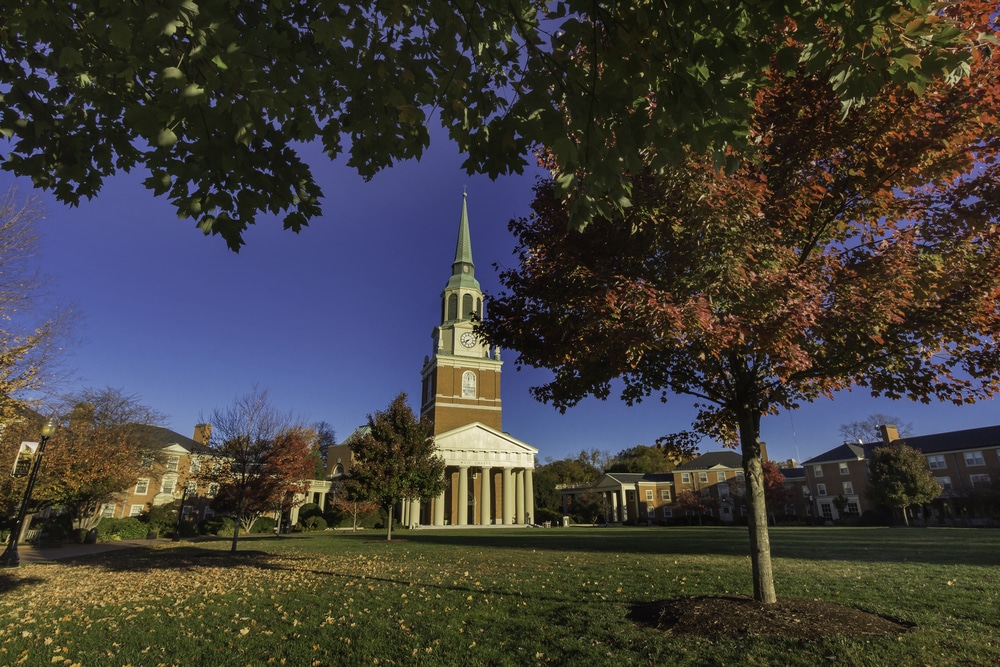Wake Forest vs the University of Virginia
Choosing the right college or university can be a daunting task. With so many options available, it’s important to do your research to find the right fit for you. In this article, we’ll compare two prestigious universities, Wake Forest vs the University of Virginia, to help you make an informed decision about which school is right for you.
Location and Campus Comparison: Wake Forest vs University of Virginia
When it comes to location and campus, Wake Forest and the University of Virginia offer two different options. Wake Forest is located in Winston-Salem, North Carolina, while the University of Virginia is located in Charlottesville, Virginia.
Wake Forest’s campus spans across 340 acres and is characterized by lush greenery and stunning architecture. With a student population of around 5,000 undergraduates, the campus is known for being intimate and supportive.
In contrast, the University of Virginia’s campus is spread out across 1,682 acres and is considered a UNESCO World Heritage Site. The campus is home to over 16,000 undergraduate students, making it significantly larger than Wake Forest.
Despite the size difference, both campuses offer a variety of resources and opportunities for students. Wake Forest has a strong focus on undergraduate research, with many students participating in projects alongside faculty members. The University of Virginia, on the other hand, is known for its prestigious graduate programs and research facilities. Additionally, both campuses have a rich history and offer numerous cultural and recreational activities for students to enjoy.
Academic Programs and Majors: A Detailed Comparison
Academic programs and majors are a crucial factor to consider when choosing a university. At Wake Forest, the most popular majors include Business Administration, Communications, Psychology, and Biology. In contrast, the University of Virginia is known for its strong academic programs in Political Science, Economics, Biology, and Psychology.
Both schools offer a wide range of undergraduate and graduate programs, as well as research opportunities. If research is a particular area of interest, both schools offer numerous research centers and initiatives, providing students opportunities to delve deeply in their areas of study.
It is important to note that while both Wake Forest and the University of Virginia offer strong academic programs, they have different approaches to education. Wake Forest emphasizes a liberal arts education, with a focus on critical thinking and interdisciplinary studies. On the other hand, the University of Virginia has a more traditional approach, with a strong emphasis on research and specialization within a particular field.
Faculty and Student Ratio: Which School Offers a Better Learning Experience?
A university’s faculty and student ratio is an essential factor that affects the quality of education. At Wake Forest, the student to faculty ratio is 10:1, allowing for individualized attention and fostering an intimate learning environment. Compared to Wake Forest, the University of Virginia has a slightly larger student to faculty ratio of 15:1. However, the faculty at the University of Virginia are renowned thought leaders in their fields, providing students with an outstanding educational experience.
It is important to note that while the student to faculty ratio is a significant factor in determining the quality of education, it is not the only factor. Other factors such as the curriculum, resources, and extracurricular activities also play a crucial role in shaping a student’s learning experience. Therefore, it is essential to consider all aspects of a university before making a decision on where to attend.
Admissions Criteria: How to Get Admitted to Wake Forest and University of Virginia
Admissions criteria is the first step in choosing a university. At Wake Forest, the admissions process is highly competitive, with an acceptance rate of 29.8%. The university considers many factors during the application process, including academic performance, test scores, extracurricular activities, and recommendations.
On the other hand, University of Virginia has an acceptance rate of 26%, and admissions officers consider a wide range of factors, including academic performance, extracurricular activities, and essays. The school also utilizes a holistic admissions process, which aims to get a more comprehensive view of each applicant’s personality and achievements.
It is important to note that both Wake Forest and University of Virginia also consider demonstrated interest as a factor in the admissions process. This means that applicants who have shown a genuine interest in the school, through campus visits, interviews, or other interactions, may have an advantage in the admissions process. Additionally, both schools offer early decision and early action options, which can increase an applicant’s chances of acceptance. However, it is important to carefully consider the commitment of applying early decision, as it is binding and requires a commitment to attend if accepted.
Student Life: Extracurricular Activities and Campus Events at Wake Forest and University of Virginia
Student life is an essential part of the college experience. Both Wake Forest and the University of Virginia offer numerous extracurricular activities, clubs, and organizations for students to get involved in.
At Wake Forest, students can participate in more than 250 organizations. These include clubs for music, theater, politics, service, sports, and more. The University of Virginia boasts over 600 student organizations spanning various fields: service, academic, cultural, sports, and more. Students also have access to a range of campus events, including guest lectures, concerts, and film screenings.
Additionally, both universities have a strong Greek life presence. Wake Forest has 14 fraternities and 10 sororities, while the University of Virginia has 30 fraternities and 16 sororities. Greek life provides students with opportunities to form close-knit communities, participate in philanthropic events, and develop leadership skills.
Housing and Dining Options: Which School Offers Better Amenities?
Where you live and eat is essential to your quality of life at a university. Wake Forest offers students a range of housing options, including traditional dorms, apartments, and fraternity and sorority houses. The campus offers a range of dining options, including food courts, coffee shops, and cafes.
The University of Virginia provides plenty of dormitory space for students, along with location-affiliated housing, on-and-off campus houses and apartments, and a unique residential college system. There are numerous dining options available on campus, including cafes, restaurants, and campus food courts.
Additionally, Wake Forest has recently renovated several of its residence halls, including the construction of new apartment-style housing. The university also offers themed housing options, such as wellness and sustainability-focused communities, to cater to students’ interests and lifestyles.
Meanwhile, the University of Virginia’s residential college system provides students with a unique living and learning experience. Each residential college has its own faculty director and offers a variety of academic and social programs, creating a tight-knit community within the larger university.
Tuition Fees and Financial Aid: A Comprehensive Comparison
College fees and financial aid opportunities are critical for many students and families. At Wake Forest, the annual tuition cost for undergraduate students is around $55,000, and the school provides need-blind financial aid. A total of 38% of students receive some form of need-based aid from the university.
University of Virginia’s annual tuition cost is around $50,000, and the university is committed to meeting the demonstrated financial need of all admitted students. More than 40% of students receive need-based financial aid from the university.
It is important to note that tuition fees and financial aid packages can vary greatly between different colleges and universities. For example, some schools may offer merit-based scholarships in addition to need-based aid, while others may have higher tuition costs but more generous financial aid packages. It is crucial for students and families to research and compare the costs and benefits of different schools before making a decision on where to attend.
Job Prospects after Graduation: Which School Has Better Career Opportunities?
Job prospects after graduation are often the deciding factor in where students choose to attend college. Wake Forest boasts an impressive 90% job placement rate for graduates, with a median starting salary of around $59,000. The university has a strong alumni network and helps prepare students for their careers through its Career Development Center.
The University of Virginia also has a robust Career Center, providing students with career advice and preparing them for their professional lives. The university has an 89% job placement rate for graduates, with a median starting salary of around $61,000.
However, job prospects are not the only factor to consider when choosing a college. Wake Forest is located in a small town, which may limit networking opportunities for students. On the other hand, the University of Virginia is located in a larger city, providing students with more access to internships and job opportunities.
Another important consideration is the specific industries and companies that recruit from each school. Wake Forest has strong connections with companies in the healthcare and finance industries, while the University of Virginia has a strong presence in the technology and consulting industries. Students should research the industries and companies that align with their career goals before making a decision.
Wake Forest vs the University of Virginia: Student Reviews and Testimonials
Student reviews and testimonials of a university provide an objective perspective of what it’s like to study and live in each school. At Wake Forest, many current students praise the university for its supportive community, personalized attention, and strong academic programs. Students also appreciate the university’s focus on student well-being and mental health.
Students attending the University of Virginia rave about the outstanding campus, well-respected academic programs, and strong sense of community at the university. Many students also highlight the campus’s extensive research opportunities.
Another aspect that Wake Forest students appreciate is the university’s commitment to diversity and inclusion. The school offers a variety of resources and programs to support underrepresented groups on campus. Additionally, many students take advantage of the university’s study abroad programs, which allow them to gain valuable international experience and broaden their perspectives.
At the University of Virginia, students also benefit from the school’s strong alumni network. Graduates of the university are highly successful in their fields and often provide mentorship and career opportunities to current students. The university also offers a wide range of extracurricular activities, including sports teams, clubs, and organizations, which allow students to pursue their interests and make connections with like-minded individuals.
Wake Forest vs the University of Virginia: Alumni Network
The alumni network of a university can play a big role in career opportunities after graduation. Wake Forest has a robust alumni network with over 100,000 graduates worldwide. Many of the alumni hold prominent positions in a variety of fields, including politics, law, business, and entertainment.
The University of Virginia also has a strong alumni network, with more than 254,000 alumni around the world. UVA alumni have gone on to make their marks in various fields, such as business, politics, and entertainment.
However, when it comes to alumni engagement, Wake Forest takes the lead. The university has a dedicated alumni association that hosts events and provides resources for alumni to stay connected with each other and the university. Wake Forest also has a mentorship program that pairs current students with alumni in their desired career fields. This program has helped many students secure internships and job opportunities after graduation.
Wake Forest vs the University of Virginia: Rankings and Accolades
Both Wake Forest and the University of Virginia consistently rank highly in national rankings. Wake Forest is ranked #27 in the 2022 edition of Best Colleges according to US News & World Report, with high rankings for undergraduate teaching, innovation, and alumni giving.
The University of Virginia is ranked #25 in the 2022 edition of Best Colleges and #9 in Top Public Schools. The university received high rankings for its academics, value, and graduation rates.
Despite their similarities in national rankings, there are some notable differences between Wake Forest and the University of Virginia. Wake Forest is a private university located in Winston-Salem, North Carolina, while the University of Virginia is a public university located in Charlottesville, Virginia.
Additionally, Wake Forest has a smaller student body with a total enrollment of around 8,000 students, while the University of Virginia has a larger student body with a total enrollment of around 24,000 students. These differences in size and location can greatly impact the student experience and opportunities available at each university.
Wake Forest vs the University of Virginia: Sports Programs
Both Wake Forest and the University of Virginia have strong athletics departments and competitive sports programs. Wake Forest is a member of the Atlantic Coast Conference and fields teams in 16 sports. The athletics department prides itself on achieving excellence in both academics and athletics.
The University of Virginia also has a highly competitive athletics department and has won numerous national championships across a range of sports, including football, basketball, and swimming. The athletics department also emphasizes the importance of academics, with a strong focus on the well-being of student-athletes.
Additionally, both schools offer a variety of intramural and club sports for students who are not on varsity teams. These programs provide opportunities for students to stay active and compete in a more casual setting. Wake Forest offers intramural sports such as flag football, volleyball, and ultimate frisbee, while the University of Virginia offers club sports such as rugby, field hockey, and sailing. These programs are a great way for students to get involved in sports and meet new people on campus.
Wake Forest vs the University of Virginia: Diversity on Campus
Diversity on campus is an essential aspect to consider when choosing a university. Wake Forest prides itself on its inclusive community, with a diverse student body. The undergraduate student population includes 31% minorities and 11.1% international students.
The University of Virginia has a diverse student population with 45% minority students. The undergraduate student body also includes international students from more than 100 countries. The university emphasizes diversity and inclusivity through various initiatives, including the Office for Diversity, Equity, and Inclusion.
Despite the efforts of both universities to promote diversity, there are still some differences in the representation of certain groups. For example, Wake Forest has a higher percentage of Hispanic/Latino students at 8.5%, compared to the University of Virginia’s 6%. On the other hand, the University of Virginia has a higher percentage of African American students at 22%, compared to Wake Forest’s 7%.
It is important to note that diversity goes beyond just race and ethnicity. Both universities also have a diverse range of students in terms of socioeconomic status, religion, sexual orientation, and more. Wake Forest has a LGBTQ Center that provides resources and support for LGBTQ students, while the University of Virginia has a Multicultural Student Center that serves as a hub for students of different backgrounds to connect and engage with each other.
Conclusion: Making Your Decision Between Wake Forest and the University of Virginia
Choosing between Wake Forest and the University of Virginia can be a challenging decision. Both universities offer a strong academic program, a supportive community, and a range of student activities. Factors such as location, sports, and diversity on campus may influence your decision. Ultimately, the decision to choose the right university comes down to individual preferences and goals.
By conducting thorough research, analyzing your priorities, and carefully assessing your options, you can decide which university is the perfect fit for you. We hope this comparison of Wake Forest and the University of Virginia has been helpful in your decision-making process.
It is important to note that both Wake Forest and the University of Virginia have unique campus cultures. Wake Forest is known for its close-knit community and emphasis on personal relationships between students and faculty. On the other hand, the University of Virginia has a strong tradition of student self-governance and a vibrant social scene. Consider these cultural differences when making your decision, as they can greatly impact your overall college experience.
How AdmissionSight Can Help You With College Admissions
AdmissionSight is a college consulting firm that provides personalized assistance to students throughout the college admissions process. Here are some ways that AdmissionSight can help you:
Admissions strategy: AdmissionSight can help you develop a strategic plan for your college application process. Our professional consultants can assist with identifying schools that are a good fit for your academic, extracurricular, and personal goals and help you plan and prioritize your application strategy.
Application review: AdmissionSight can review your application and provide feedback on how to improve it. We can offer suggestions on making your application stand out and highlighting your strengths and unique qualities.
Essay coaching: AdmissionSight can help you craft compelling essays that showcase your personality, goals, and achievements. We can guide you through the essay writing process and provide feedback on your drafts to help you refine your writing.
Interview preparation: AdmissionSight can provide interview coaching to help you feel confident and prepared for college interviews. Our experts can offer tips on how to present yourself professionally and how to answer common interview questions.
Extracurricular planning: AdmissionSight can help you plan and develop your extracurricular activities to make them more impactful and meaningful. We can suggest activities that align with your interests and goals and provide guidance on demonstrating your leadership and initiative.
Overall, AdmissionSight can provide valuable guidance and support throughout the college admissions process to help you maximize your chances of getting accepted into the college of your choice.
With a high success rate of over 75%, we have built a strong network in the past decade. Book an initial consultation today, free of charge!










































